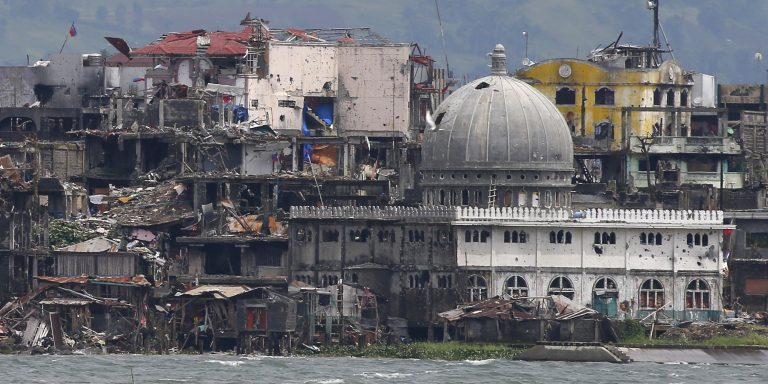INTELBRIEF
May 25, 2018
IntelBrief: The Philippines: a Complex Security Situation

- A year ago this week, ISIS-affiliated insurgents infiltrated Marawi City on the Philippine island of Mindanao, setting the stage for a five-month battle that left much of the city in ruins.
- Redevelopment in the city could exacerbate underlying grievances, including about public corruption and lack of opportunity, providing new fodder for terrorists to recruit.
- Relatively underdeveloped despite rich resources, Mindanao features rough geography and complex ethnography, complicating counter-insurgency efforts.
- In large cities, especially in Manila, Muslims face employment discrimination, potentially increasing radicalization risks.
.
A year ago this week in the Philippines, militants from the Abu Sayyaf Group (ASG), a terrorist group affiliated with the so-called Islamic State, along with the Maute—another criminal-cum-terrorist group in the Philippines—resisted an attempt by the Filipino army to capture ASG leader Isnilon Hapilon in the Islamic City of Marawi. Marawi is the capital of Lanao del Sur Province and home to 200,000 people—almost all Muslims in this overwhelmingly Catholic country. By mid-October, after five months of urban warfare, Hapilon was dead, as was Maute leader Omar Maute, and the effort to establish an Islamic State province on Mindanao had failed. Much of the city lay in ruins. It was the second time in five years that a Muslim militant group had attacked a Mindanao city. In 2013, a faction of the Moro National Liberation Front (MNLF) had attacked the center of Zamboanga City and raised its flag there.
In late 2016, the Filipino military was enjoying considerable success against the Maute, who had been running a protection racket in remoter parts of Lanao del Sur. President Rodrigo Duterte in December had dared the Maute to attack Marawi. The Maute have kinship ties to the Moro Islamic Liberation Front (MILF), which, along with the MNLF, had been agitating since the 1970s for independence for Mindanao’s roughly 40% Muslim minority. While an autonomous Muslim-majority region comprising several provinces was formed in 1989, implementation has proven difficult, and grievances have festered. Although rich in minerals and home to successful agribusinesses, Mindanao and the smaller islands near it remain less developed than many other parts of the country. The people, however, are proud of a centuries-long tradition of resisting outside influences, including by not just other Filipinos, but also Spaniards, Americans, and Japanese. While it is not a surprise that fighters showed up to battle the military, the fact that bin Ladenismwas leveraged to motivate them shows just how far and compelling is that ideology’s reach.
In the wake of the Marawi City crisis, development organizations have flowed resources to Mindanao, with a particular emphasis on improving basic education. However, skilled jobs are not plentiful in the region, and Muslim Filipinos frequently complain of employment discrimination in Manila and other major cities. Millions of Filipinos work abroad, including in Gulf countries. Many Filipinos fear that overseas workers who return home, especially those who converted to Islam while in the Gulf, may present an elevated security risk. Radicalization in notoriously overcrowded Filipino prisons is a major concern; risk assessments and segregation of prisoners are rare, gangs are incorporated into prison governance, and radicalization-enabling corruption of guard forces is rampant. A neighborhood near the detention facility in Manila where many MNLF members are held is filled with the families of the detainees. Mostly undereducated, few of these family members have good jobs or long-term economic prospects, yet they cannot return home.
Meanwhile, a consortium of Chinese and Filipino companies is gearing up to redevelop the conflict-ravaged areas of Marawi City. How much of the city’s architectural character will survive and what enduring employment opportunities will be created remain to be seen. Included in the group are two Chinese firms that were banned from World Bank-funded projects following a 2009 investigation of construction bid-rigging.
.
For tailored research and analysis, please contact: info@thesoufancenter.org
[video width="960" height="540" mp4="https://thesoufancenter.org/wp-content/uploads/2018/05/Final-Edit-1-202.mp4" poster="https://thesoufancenter.org/wp-content/uploads/2018/05/AP_17332788069741.jpg"][/video]